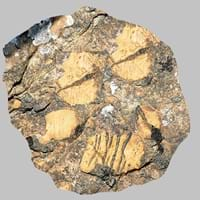Definition
Diamictite is a sedimentary rock that consists of non-sorted to poorly sorted terrigenous sediment containing particles that range in size from clay to boulders, suspended in a matrix of mudstone or sandstone
Aplite is a fine-grained granite composed mainly of feldspar and quartz
Origin
Southern Mongolia
Iran
Discoverer
Unknown
Unknown
Etymology
From Greek dia through and meiktós or mixed
From German Aplit, from Greek haploos simple + -ite
Class
Sedimentary Rocks
Igneous Rocks
Sub-Class
Durable Rock, Soft Rock
Durable Rock, Hard Rock
Group
Not Applicable
Plutonic
Other Categories
Coarse Grained Rock, Opaque Rock
Fine Grained Rock, Opaque Rock
Texture
Clastic
Granular, Graphic
Color
Brown, Buff
Black, Grey, Orange, Pink, White
Durability
Durable
Durable
Appearance
Banded
Veined or Pebbled
Interior Uses
Decorative Aggregates, Interior Decoration
Bathrooms, Countertops, Decorative Aggregates, Entryways, Floor Tiles, Homes, Hotels, Kitchens, Stair Treads
Exterior Uses
As Building Stone, Paving Stone
As Building Stone, As Facing Stone, Bridges, Paving Stone, Near Swimming Pools, Office Buildings, Resorts
Other Architectural Uses
Curbing
Curbing
Construction Industry
As Dimension Stone, Construction Aggregate, for Road Aggregate, Landscaping, Roadstone
As Dimension Stone
Medical Industry
Not Yet Used
Not Yet Used
Antiquity Uses
Artifacts
Artifacts, Monuments, Sculpture, Small Figurines
Commercial Uses
Commemorative Tablets, Creating Artwork, Production of Lime
Curling, Gemstone, Laboratory bench tops, Small Sculptures, Tombstones
Types
Bedded Diamictite and Laminated Diamictite
Not Available
Features
Host Rock for Lead, Is one of the oldest rock
Available in lots of colors, Available in Lots of Colors and Patterns, Is one of the oldest rock
Archaeological Significance
Monuments
Not Yet Used
Used
Famous Monuments
Not Applicable
Data Not Available
Sculpture
Not Yet Used
Used
Famous Sculptures
Not Applicable
Data Not Available
Pictographs
Used
Not Used
Petroglyphs
Used
Not Used
Figurines
Not Yet Used
Used
Formation
Diamictite is unevenly sorted terrigenous, non-calcareous sedimentary rock which forms due to weathering of mudstone and sandstone.
Aplites belong to intrusive igneous rocks which are mostly quart and alkali feldspar and are formed from residual eutectic granitic liquids and represent the final crystallization products of magma.
Mineral Content
Calcite, Clay, Feldspar, Micas, Quartz
Amphibole, Biotite, Feldspar, Hornblade, Micas, Muscovite or Illite, Plagioclase, Pyroxene, Quartz
Compound Content
Not Available
Aluminium Oxide, CaO, Iron(III) Oxide, FeO, Potassium Oxide, MgO, MnO, Sodium Oxide, Phosphorus Pentoxide, Silicon Dioxide, Titanium Dioxide
Types of Metamorphism
Not Applicable
Burial Metamorphism, Cataclastic Metamorphism, Hydrothermal Metamorphism, Regional Metamorphism
Types of Weathering
Biological Weathering, Chemical Weathering
Chemical Weathering, Mechanical Weathering
Types of Erosion
Chemical Erosion, Coastal Erosion, Water Erosion
Chemical Erosion, Coastal Erosion, Wind Erosion
Grain Size
Coarse Grained
Very fine-grained
Fracture
Conchoidal to Uneven
Not Available
Streak
Light to dark brown
White
Porosity
Highly Porous
Less Porous
Luster
Grainy, Pearly and Vitreous
Dull to Pearly to Subvitreous
Compressive Strength
Not Available
Cleavage
Not Available
Not Available
Toughness
Not Available
Not Available
Specific Gravity
4.3-5.0
2.6
Transparency
Opaque
Opaque
Density
2.2-2.35 g/cm3
2.6 g/cm3
Resistance
Heat Resistant, Impact Resistant
Heat Resistant, Wear Resistant
Deposits in Eastern Continents
Asia
China, India, Kazakhstan, Mongolia, Russia
China, India, Iran, Saudi Arabia, Sri Lanka, Taiwan, Thailand, Turkey, Vietnam
Africa
Namibia, Nigeria, South Africa
Angola, Egypt, Madagascar, Namibia, Nigeria, South Africa
Europe
Austria, Denmark, Germany, Great Britain, Netherlands, Norway, Poland, Sweden, Switzerland, United Kingdom
Austria, Belgium, Finland, France, Germany, Italy, Norway, Sardinia, Spain, Switzerland, The Czech Republic, Venezuela
Others
Not Yet Found
Not Yet Found
Deposits in Western Continents
North America
Canada, USA
Canada, USA
South America
Brazil, Venezuela
Not Yet Found
Deposits in Oceania Continent
Australia
New South Wales, New Zealand
Not Yet Found










